To the Head of the Class
The Tesla Model 3 gets the buzz, the Chevrolet Bolt and Nissan Leaf are known entities. Then along comes the all-new 2019 Kia Niro EV that should start getting the well-deserved attention as arguably the best in class electric vehicle under $37,000.
Kia recently invited two dozen automotive journalists to Northern California for a first drive experience in the Niro EV. We were handed the keys to one of the nifty small crossovers at the San Jose Airport and instructed to follow the navigation, over Highway 17, through the Santa Cruz Mountains and into Santa Cruz, about a 30-mile drive. The front-wheel drive Niro EV handled the nearly 1,800-foot elevation rise with ease, climbing and cornering without any challenges to the 150-kilowatt electric motor.
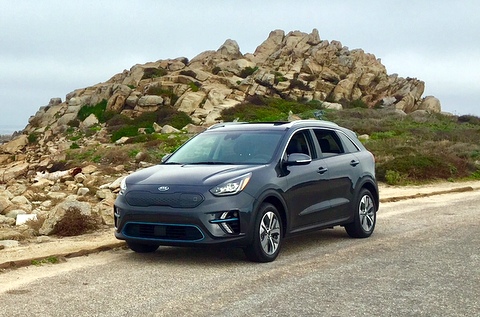
The Kia Niro first came onto the scene as a 2017 hybrid, a year later the 2018 PHEV (plug-in hybrid electric vehicle), and now to complete the trio, the 2019 EV. Clean Fleet Report has reviewed the Niro Hybrid and PHEV (check out the review links at the end of this story). Kia’s self-described “commitment to both people and nature” is reinforced by its eco-friendly philosophy, management and cars, something Clean Fleet Report applauds.
Smooth Operator
The Niro EV shares its drivetrain with the Hyundai Kona EV, both producing 201 horsepower and 291 pound-feet of torque. Zero-to-60 times are just under eight seconds, but it felt quicker than that, especially when zipping around town and when in the sport mode. The three other driver-selectable drive modes are eco, eco+ and normal, with eco being the default setting. Eco is the compromise setting for range and responsiveness, while sport mode is where the more spirited driving will be found.

The 2019 Kia Niro EV has an EPA estimated driving range of 239 miles, but Kia has performed real-world tests that have delivered 275+ miles.
The liquid-cooled 64-kilowatt-hour lithium-ion polymer battery pack is replenished through plug-in charging and regenerative braking. The regenerative charging system converts kinetic energy into electric energy when applying the brakes or coasting and stores it in the battery. This process can be viewed on a dash gauge, where you can watch the power flow into and out of the battery and motor.
The Kia Niro EV also has the ability for one-pedal driving with the steering wheel mounted paddles. By pulling on the left paddle the Niro can be brought to a complete stop, which means you do not need to depress the brake pedal. If you keep the paddle pulled tight, the car will not creep and then will only move when you step on the accelerator.
The three plug-in charge options can all be controlled by an app, which allows you to set the day and time of charging. Here’s how long they take:
- 120V (Level 1) 17 hours
- 240V (Level 2) 5 hours
- 480V DC Fast Charging 100 miles in 30 minutes or 80 percent in 75 minutes or less
Driving Experience: On the Road
The Niro EV’s 3,854 pounds feel solid and confident on the road. The well-distributed weight is due to the under-seat battery placement, creating a low center of gravity resulting in very good driving dynamics. The motor-driven power steering was well-tuned for road feel, with maneuvering in town, especially parking, being easy. The front MacPherson struts and rear multi-link suspension delivered a smooth and stable ride. Tire and wind noise were at a minimum, with the road surface the determining factor for the 17-inch alloy wheels and 215/55R low-rolling-resistance tires transmitting noise to the cabin. When pushing corners a bit too fast, there was minor body roll.
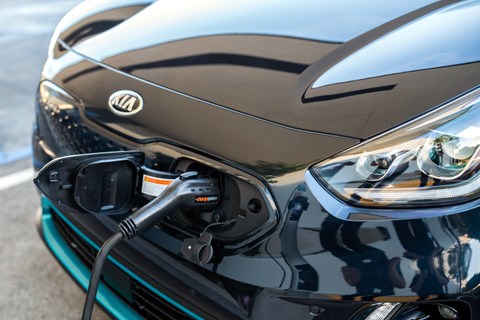
The previously mentioned regenerative braking system has four-wheel disc brakes with ABS and brake assist. The stops were straight and true, with no brake fade and a pleasant hybrid braking whine when stopping.
But what is that other noise when driving under 20 miles per hour? Have aliens landed? Not quite, but the sci-fi whirring noise, heard when driving slowly, is the pedestrian warning system. Consisting of a speaker mounted behind the front bumper, this futuristic sound makes it so pedestrians have an idea the Niro EV is close by. Without it, there is no sound at all coming from this all-electric crossover.
Smooth Design: In and Out
With the hybrid and PHEV Niro models preceding the EV version, what differentiates them from each other? Kia as taken the stylish and uncluttered Niro and added a few EV-only bits and pieces. The front fascia has the grill closed off with a diamond-patterned faceplate, and the lower air intake is trimmed with a tasteful blue accent. The charge door is located on the front, which is far more convenient than when placed on either fender.
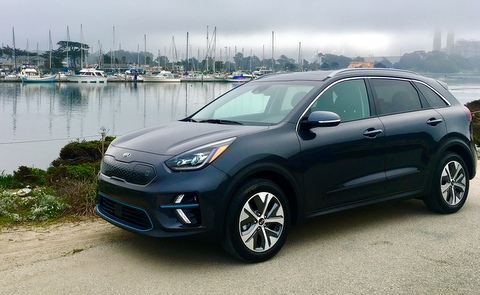
LED daytime running lights are located in the bottom fascia, completing the front end design. The side profile draws a nice line to the A pillars, leading to a gently sloping roof with rack rails, a shark fin antenna and an integrated spoiler over the rear hatch window. The horizontal LED taillights and smooth surfaced hatch finish off the attractive rear. Blue accents adorn the lower rear fascia, with a very demure “Eco electric” badge on the lower right corner of the hatch.
Climbing inside, the spacious cabin includes ample leg and headroom for two six-footers in the rear seat, separated by a center armrest with cup holders. If there are no passengers out back, fold down the 60/40 split rear seat and the storage area is not only impressive, but access is easy through the large hatch opening. Plus, the flat load floor provides for extra cabin space and legroom.
The leather-trimmed heated and ventilated front seats were comfortable and supportive. The driver gets 10-way power adjustable with lumbar, while the passenger gets six-way manual adjustments. We like that the view off the road is from a higher vantage point than a sedan (6.1-inch ground clearance), but not as high as a SUV.
The center dash in our Niro EV Premium came with an 8.0-inch touchscreen housing Kia’s UVO eServices infotainment system, which included Android Auto and Apple CarPlay with smartphone integration via Bluetooth. The eight-speaker Harman Kardon sound system, with a subwoofer, plays AM/FM/CD/MP3/AUX and Sirius/XM. The leather-wrapped steering wheel had controls for audio, telephone and cruise control. Big thanks to Kia designers for the knobs and wheels to control the radio and automatic temperature control.
Safety and Warranties
The Niro EV comes with an extensive, inclusive and impressive list of standard safety features. They include seven airbags, forward emergency braking and collision warning, stability control, smart cruise control, blind spot monitoring, park assist with front and rear sensors, vehicle stability management, traction control, hill start assist, a tire pressure monitoring system, engine immobilizer, lane departure warning and rear cross traffic alert.
The 2019 Kia Niro EV has not been rated by the National Highway and Safety Administration (NHTSA) or the Insurance Institute fo Highway Safety (IIHS). However, the IIHS did rate the 2019 Niro PHEV as a Top Safety pick, its highest rank.
The 2019 Niro EV comes with these warranties:
- Powertrain 10 years/100,000 miles
- Battery 10 years/150,000 or 100,000 miles (depending on state)
- Basic Five years/60,000 miles
- Roadside Assistance Five years/60,000 miles
- Corrosion 10 years/Unlimited miles
Pricing
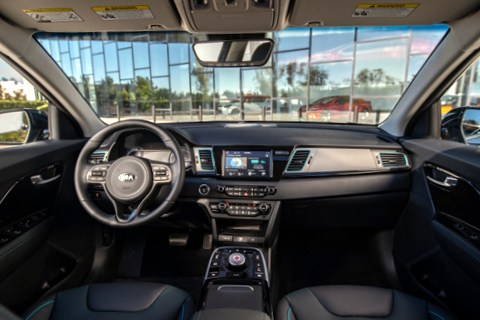
Pricing has not been announced, so check with your Kia dealer, but the expected price range for the 2019 Kia Niro EV is $36,500 – $41,000. The Niro EV qualifies for federal and state credits, and in some states, is eligible for a HOV sticker.
When it does go on sale, it will be available in the 12 ZEV (Zero Emission Vehicle) states: CA, OR, WA, NY, NJ, MD, MA, CT, RI, TX, WA, HI.
Observations: 2019 Kia Niro EV
Kia is all-in with vehicle electrification, and Clean Fleet Report is glad they are. We have reviewed all their hybrid, plug-in hybrid, and electric vehicles, and have been impressed with them all. Kia completing the Niro family with the all-electric version places them in the rare air of competing head-to-head with these cars. Alphabetical, with range and base MSRP.
- BMW i3 – 153 miles @ $44,450
- Chevrolet Bolt – 238 miles @ $37,495
- Hyundai Ioniq EV – 124 miles @ $29,815
- Hyundai Kona EV – 258 miles @ $36,450
- 2019 Nissan Leaf Plus– 226 miles @ $39,990 (est., available this spring)
- Tesla Model 3 (Mid-range)- 264 miles @ $42,900
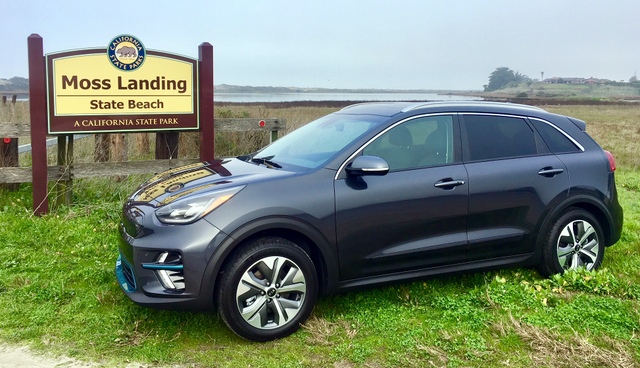
For versatility, ride, comfort, range, and standard safety equipment, the 2019 Kia Niro EV is hard to beat. Before visiting your Kia dealer, do some homework on the competitors, talk with your tax advisor for clarity on the federal and state credits, and then make an appointment to meet with a Kia factory trained electric vehicle specialist.
Then, don’t be surprised if you drive home in a Niro EV.
Make sure to opt-in to the Clean Fleet Report newsletter (top right of page) to be notified of all new stories and vehicle reviews.
Whatever you buy, Happy Driving!
Related Stories You Might Enjoy—Niro variations & the growing long-range EV crowd
First Drive: 2017 Kia Niro Hybrid
News: 2018 Kia Niro PHEV Introduced
Road Test: 2017 Kia Niro Hybrid (John’s view)
Road Test: 2017 Kia Niro Hybrid (Steve’s view)
Road Test: 2017 Kia Niro Hybrid (Larry’s view)
Road Test: 2017 Kia Niro FE Hybrid
Road Test: 2018 Kia Niro PHEV (John’s view)
Road Test: 2018 Kia Niro PHEV (Steve’s view)
LA Auto Show: 2019 Kia Niro EV Debut
CES News: 2019 Nissan Leaf Plus Goes the Distance
Personal: My Two Years with the Chevrolet Bolt EV
News: Tesla Model 3 the Story of the Year
News: BMW Electification Push
Road Test: 2017 Hyundai Ioniq EV
Disclosure:
Clean Fleet Report is loaned free test vehicles from automakers to evaluate, typically for a week at a time. Our road tests are based on this one-week drive of a new vehicle. Because of this we don’t address issues such as long-term reliability or total cost of ownership. In addition, we are often invited to manufacturer events highlighting new vehicles or technology. As part of these events we may be offered free transportation, lodging or meals. We do our best to present our unvarnished evaluations of vehicles and news irrespective of these inducements.
Our focus is on vehicles that offer the best fuel economy in their class, which leads us to emphasize electric cars, plug-in hybrids, hybrids and diesels. We also feature those efficient gas-powered vehicles that are among the top mpg vehicles in their class. In addition, we aim to offer reviews and news on advanced technology and the alternative fuel vehicle market. We welcome any feedback from vehicle owners and are dedicated to providing a forum for alternative viewpoints. Please let us know your views at publisher@cleanfleetreport.com.


3 thoughts on “Road Test: 2019 Kia Niro EV”